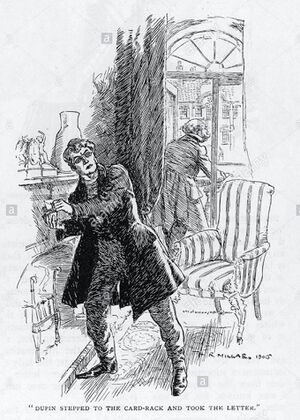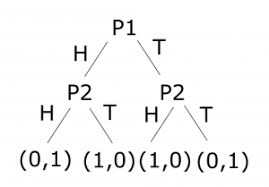Odd or Even?: Difference between revisions
No edit summary |
No edit summary |
||
| (One intermediate revision by the same user not shown) | |||
| Line 2: | Line 2: | ||
[[File:OddOrEvenPlayerOdds.jpeg|thumb|Diagram of the odds of odd or even (player one, player two, heads, tails)]] | [[File:OddOrEvenPlayerOdds.jpeg|thumb|Diagram of the odds of odd or even (player one, player two, heads, tails)]] | ||
<p class="preamble">''To briefly recap'': In a previous chapter I | <p class="preamble">''To briefly recap'': In a previous chapter I discussed the implications of the cybernetic discourse for Lacan, particularly in relation Freud’s notion of psychodynamics. I established how Lacan considered cybernetics to have had a substantial impact on discourse itself as we moved from the discourse on knowledge to the discourse of the machine. Indeed, the cybernetic discourse of homeostasis, circuitry, and regulative feedback continued to be central to Lacan’s ''Seminar II'' as it progressed.<br> | ||
<br> | <br> | ||
In his analysis of Edgar Allan Poe’s ''The Tale of the Purloined Letter'', and in his lecture on Cybernetics and the Unconscious, Lacan | In his analysis of Edgar Allan Poe’s ''The Tale of the Purloined Letter'', and in his lecture on Cybernetics and the Unconscious, Lacan discussed Von Neumann & Morgenstern's ''Game Theory and Economic Behaviour''; and the game of odds & evens (which was discussed in both Poe’s story and in Von Neumann & Morgenstern's book). Lacan also described a “second guessing” finite state automata (similar to Shannon & Hagelbarger’s SEER) in order to outline the tendency of symbolic apparatus (be they begotten or man-made) to produce patterns which entered the circuitry of signification.</p> | ||
Lacan’s seminar on the Purloined Letter, | Lacan’s seminar on the Purloined Letter, part of ''Seminar II'', was a public manifestation of a dialogue that had been going on for some time, principally with the author of ''What is Cybernetics?'' (1954) – who was also the co-organiser of the Paris congresses on cybernetics (1950-1951) – Georges Theodule Guilbaud. | ||
Guilbaud’s ''Lectures on the Principal Elements in the Mathematical Theory of Games''(1954) | Guilbaud’s ''Lectures on the Principal Elements in the Mathematical Theory of Games''(1954) made explicit reference to Edgar Allan Poe’s Purloined Letter. In various other texts Guilbaud noted the game of odd or even (ones & twos), mentioned in Poe’s tale as equivalent to Matching Pennies, the game cited for similar analysis by Neumann and Morgenstern in ''Theory of Games and Economic Behavior'' (1944).<ref>Liu, Lydia H. ''The Freudian Robot: Digital Media and the Future of the Unconscious''. Chicago: University of Chicago Press, 2011. p.301</ref> In Guilbaud’s lecture ''Pilots, Planners, and Gamblers: Toward a Theory of Human Control'', Guilbard posited the idea that the game of Odds & Evens presented the possibility of the mathematicians’ dream – the pure game (''jeu pur''). In this lecture Guilbaud also cited an earlier work by Jacques Lacan, ''Logical Time and the Assertion of Anticipated Certainty'', (1945) which discussed Neumann and Morgenstern’s ''Theory of Games and Economic Behavior'' no more than a year after its publication.<ref> Liu''The Freudian Robot: Digital Media and the Future of the Unconscious''. Chicago, IL: University of Chicago Press, 2011.301 </ref> For Lacan the game theory of Neumann and Morgenstern, the communications theory of Shannon and the notion of the (theoretical) universal machine conceived by Turing allowed for a wholly up-to-date conception of the unconscious.<ref>Lacan, Jacques, and Miller, Jacques-Alain . The Seminar of Jacques Lacan: Book 2: The Ego in Freud's Theory and in the Technique of Psychoanalysis 1954-1955. Cambridge: CUP Archive, 1988. (Seminar on the Purloined Letter) p?</ref> By 1954, as Lacan opened his seminar, a particular kind of machine had emerged that both illustrated and performed the formation of the subject in exterior relation to the machinery of the game. It was specifically finite state automata such as the SEquence Extrapolating Robot (SEER) that allowed Lacan to claim that “the symbolic world is the world of the machine.” | ||
In the case of the tortoise and in the finite state automata, the same relation | In the case of the tortoise and in the finite state automata, the same relation was established. Both machines – in their encoding and in their production of symbolic material (be they conscious or not) – demanded an encounter with an other. | ||
<p class="body-quote"> | <p class="body-quote"> | ||
Latest revision as of 13:22, 22 February 2022


To briefly recap: In a previous chapter I discussed the implications of the cybernetic discourse for Lacan, particularly in relation Freud’s notion of psychodynamics. I established how Lacan considered cybernetics to have had a substantial impact on discourse itself as we moved from the discourse on knowledge to the discourse of the machine. Indeed, the cybernetic discourse of homeostasis, circuitry, and regulative feedback continued to be central to Lacan’s Seminar II as it progressed.
In his analysis of Edgar Allan Poe’s The Tale of the Purloined Letter, and in his lecture on Cybernetics and the Unconscious, Lacan discussed Von Neumann & Morgenstern's Game Theory and Economic Behaviour; and the game of odds & evens (which was discussed in both Poe’s story and in Von Neumann & Morgenstern's book). Lacan also described a “second guessing” finite state automata (similar to Shannon & Hagelbarger’s SEER) in order to outline the tendency of symbolic apparatus (be they begotten or man-made) to produce patterns which entered the circuitry of signification.
Lacan’s seminar on the Purloined Letter, part of Seminar II, was a public manifestation of a dialogue that had been going on for some time, principally with the author of What is Cybernetics? (1954) – who was also the co-organiser of the Paris congresses on cybernetics (1950-1951) – Georges Theodule Guilbaud.
Guilbaud’s Lectures on the Principal Elements in the Mathematical Theory of Games(1954) made explicit reference to Edgar Allan Poe’s Purloined Letter. In various other texts Guilbaud noted the game of odd or even (ones & twos), mentioned in Poe’s tale as equivalent to Matching Pennies, the game cited for similar analysis by Neumann and Morgenstern in Theory of Games and Economic Behavior (1944).[1] In Guilbaud’s lecture Pilots, Planners, and Gamblers: Toward a Theory of Human Control, Guilbard posited the idea that the game of Odds & Evens presented the possibility of the mathematicians’ dream – the pure game (jeu pur). In this lecture Guilbaud also cited an earlier work by Jacques Lacan, Logical Time and the Assertion of Anticipated Certainty, (1945) which discussed Neumann and Morgenstern’s Theory of Games and Economic Behavior no more than a year after its publication.[2] For Lacan the game theory of Neumann and Morgenstern, the communications theory of Shannon and the notion of the (theoretical) universal machine conceived by Turing allowed for a wholly up-to-date conception of the unconscious.[3] By 1954, as Lacan opened his seminar, a particular kind of machine had emerged that both illustrated and performed the formation of the subject in exterior relation to the machinery of the game. It was specifically finite state automata such as the SEquence Extrapolating Robot (SEER) that allowed Lacan to claim that “the symbolic world is the world of the machine.” In the case of the tortoise and in the finite state automata, the same relation was established. Both machines – in their encoding and in their production of symbolic material (be they conscious or not) – demanded an encounter with an other.
“...when one illustrates the phenomenon of language with something as formally purified as mathematical symbols - and that is one of the reasons for putting cybernetics on the agenda - when one gives a mathematical notation of the verbum, one demonstrates in the simplest possible way that language exists completely independently of us.”[4]
Jacques Lacan’s Seminar II comes half a decade after French elite intellectuals were introduced to game theory, cybernetics and communication theory.
In Odd or even? Beyond Intersubjectivity, Lacan explains the function of a machine very similar to SEER, Lacan got participants to play odd or even (matching pennies) and to record the results (win or lose) as + or – symbols. [5] The events follow a similar narrative to the one described by playing Shannon & Hagelbarger’s SEER.
Lacan unpacks his argument carefully. He first introduces the game of odd and even as played in Poe’s story; in the game one has to guess if your opponent is holding an odd (one) or even (two) marbles in their hand; Lacan then outlines how people routinely play the game, “second-guessing” their opponent; he then outlines how a machine, lacking the capacity to “second guess”, might play the game differently. Lacan introduces the notion of randomness and the extreme difficulty the human subject has actually being random – in contrast to the non-conscious machine. Lacan also introduces the idea of recording the results as + and – in the following configurations:

I reproduce this sequence here because, as with MCulloch's Xs and dots, it is important to illustrate that the minute we start to record the +s and –s in sequence, a pattern is established. This record represents a “memory” which is exterior to the subject. Lacan will later point out that such a “memory” is different from “remembering” which is subjective, containing personal, biographical content. And yet this record, this “memory”, makes demands on our consciousness despite being exterior to it.
Lacan next outlines how the game of odd and even is played and compares it to how a human plays against a “thinking machine” (here Lacan builds his argument with the same material as McCulloch). In a human to human game a single play has no meaning (it makes no difference). There is no surprise if you hold the same (odd or even) as your opponent. In the first play you have a 50% chance of winning, on the second play a 25% by the third play you have a 12.5% of winning. You are soon caught in a play of difference where the odds decrease and the stakes rise with each play. The odds are produced by knowledge of the previous play, by knowing that the opponent knows you are caught in the chain of signification. The play produces a pattern of choices which amounts to a trail of probability, a record or memory of the game (which is why it was important for Lacan that a record of the + and – be kept when participants to the seminar played the game). Lacan points out that even at this early stage we have left the domain of the real and entered the realm of symbolic signification.[6]. This is defined by the + &– and – &+ which record each move. The fact that the + & – is written brings the player into the realm of probability. For Lacan “the very notion of probability presupposes the introduction of the symbol into the real.” [7] The order of wins and losses only makes sense when they are written down in a sequence, if it is not written down, there is nothing to win; “the pact of the game is essential to the reality of the experience sought after.”[8]
In the first few moves of odd and even, Lacan has raised three issues that will become central to our examination of his cybernetic discourse. The first is that the introduction of the symbolic into the domain of the real produces a circuit between signs, things, and subjects. Secondly, Lacan stresses the centrality of probability; as the seminar progresses, the “conjectural science” of the 1600s become central to Lacan’s discourse of cybernetics – the period of conjectural science is when probability, which studied ratios of difference, emerged as a discipline. (see next chapter). The third issue is that the simple choice establishes a difference which establishes and consolidates order (the negentropic function of selection).
Lacan next considers what happens when a human plays the machine. Again the player must make a simple choice (a difference that makes a difference). The player must then inform the machine that they won or lost. Lacan then surmises the interior workings of the machine (sketching a mechanism very similar to SEER) which
a) records the results,
b) reacts to its opponent and
c) periodically randomises its response.
The player does not know the extent of the record kept by the machine or its ability to recall that information. Lacan notes that the machine will win by virtue of the human players exhaustion, as play progresses the human would not be able to calculate the machine’s next move without recourse to (ironically) an adding machine. This summation is similar to the accounts of the operations of SEER.
Lacan next hypothesises that a player might surmise that the machine is an equal match, that the machine is identical to the player.[9] If this were the case the player would be the other to the machine. The machine would contain a “psychological profile” of its human opponent and would be capable of second guessing the human player. In such a case “a simple oscillation comes back” ordering the relation between machine and human, and the human player will resort to random choice – in this case the “psychological profile is completely eliminated”.[10] Whether the machine plays like an idiot or an intelligent human, the human will make the same play. Here Lacan articulates a central premise of von Neumann & Morganstern’s sum-zero two-player game and the mischievous psychology wired into the circuitry of Shannon & Hagelbarger’s SEER.
So, irrespective of whether your opponent is an idiot or a genius, the next stage is to play at random. Lacan recalls a random action reported to Freud, which becomes the point of fixation. A number pulled out of a hat will quickly lead the subject “to that moment when he slept with his little sister, even to the extent that he failed his baccalaureate because that morning he had masturbated”.[11] Such a realisation will force the subject to understand that there actually is no such thing as chance. Without the subject being conscious of it “the symbols continue to mount one another, to copulate, to proliferate, to fertilise each other, to jump on each other, to tear each other apart”.
Extract a single particle, like a number from a hat, a “chance” particle which makes a screen on which to order memory. Here lies the difference between remembering (a definable property of living substance) and memory (the grouping and succession of symbolically defined events). Memory involves integrations – by which something new in the string of symbols will effect what went before. There is a retroactive effect which is “specific to the structure of symbolic memory, in other words to the function of remembering.”[12]
Lacan comes back to the issue that, be it a machine or an idiot or an intelligent opponent, all that is needed for there to be a subject who asks a question is the quod: the demonstration of proof; the signal that the proof has been demonstrated (the + &–). It is on this quod that the interrogation bears.
Lacan prepares his class for the next session (The Purloined Letter), pointing out that, irrespective of the player’s intellectual acumen, after three goes it is best to play like an idiot – because after the third play: “everything loses its signification”.
- ↑ Liu, Lydia H. The Freudian Robot: Digital Media and the Future of the Unconscious. Chicago: University of Chicago Press, 2011. p.301
- ↑ LiuThe Freudian Robot: Digital Media and the Future of the Unconscious. Chicago, IL: University of Chicago Press, 2011.301
- ↑ Lacan, Jacques, and Miller, Jacques-Alain . The Seminar of Jacques Lacan: Book 2: The Ego in Freud's Theory and in the Technique of Psychoanalysis 1954-1955. Cambridge: CUP Archive, 1988. (Seminar on the Purloined Letter) p?
- ↑ Lacan, Jacques, and Miller, Jacques-Alain. The Seminar of Jacques Lacan: Book 2: The Ego in Freud's Theory and in the Technique of Psychoanalysis 1954 1955. Cambridge: CUP Archive, 1988. (Seminar on the Purloined Letter)
- ↑ Lacan, Jacques, and Miller, Jacques-Alain. The Seminar of Jacques Lacan: Book 2: The Ego in Freud's Theory and in the Technique of Psychoanalysis 1954 1955. Cambridge: CUP Archive, 1988. (Seminar on the Purloined Letter) p*
- ↑ Lacan, Jacques, and Miller, Jacques-Alain. The Seminar of Jacques Lacan: Book 2: The Ego in Freud's Theory and in the Technique of Psychoanalysis 1954 1955. Cambridge: CUP Archive, 1988.p182
- ↑ Lacan, Jacques, and Miller, Jacques-Alain. The Seminar of Jacques Lacan: Book 2: The Ego in Freud's Theory and in the Technique of Psychoanalysis 1954 1955. Cambridge: CUP Archive, 1988.
- ↑ Lacan, Jacques, and Miller, Jacques-Alain. The Seminar of Jacques Lacan: Book 2: The Ego in Freud's Theory and in the Technique of Psychoanalysis 1954 1955. Cambridge: CUP Archive, 1988. (Odd or Even) p.182)
- ↑ Lacan, Jacques, and Miller, Jacques-Alain. The Seminar of Jacques Lacan: Book 2: The Ego in Freud's Theory and in the Technique of Psychoanalysis 19541955. Cambridge: CUP Archive, 1988. (Odd or Even) p.184
- ↑ Lacan, Jacques, and Miller, Jacques-Alain. The Seminar of Jacques Lacan: Book 2: The Ego in Freud's Theory and in the Technique of Psychoanalysis 19541955. Cambridge: CUP Archive, 1988. (Odd or Even) p.184
- ↑ Lacan, Jacques, and Miller, Jacques-Alain. The Seminar of Jacques Lacan: Book 2: The Ego in Freud's Theory and in the Technique of Psychoanalysis 19541955. Cambridge: CUP Archive, 1988. (Odd or Even) p.184
- ↑ Lacan, Jacques, and Miller, Jacques-Alain. The Seminar of Jacques Lacan: Book 2: The Ego in Freud's Theory and in the Technique of Psychoanalysis 19541955. Cambridge: CUP Archive, 1988. (Odd or Even) p.185